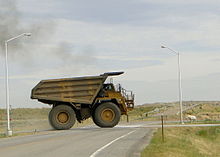Red Desert (Wyoming)
In the 19th century, the Oregon, California, and Mormon Trails crossed the Continental Divide at South Pass, just north of the Red Desert.
[2] Ponds fed by summer snowmelt attract a wide range of migratory birds such as ducks, trumpeter swans,[citation needed] and white pelicans.
Subsequent climate and tectonic activities during the lake's lifespan (four million years) saw repeated patterns of rising and falling water levels.
The former produced today's highly valued mineral trona, while the latter created coal-bed methane gas, coal, and the world's largest known oil-shale deposit.
Such small earth moving events, repeated over the eons, combined with the sculpting forces of wind have created the rugged landscape of buttes, pinnacles, gulches, and flats that characterize the Red Desert.
Steamboat Mountain and other desert mesas or buttes provide seeps and springs that serve as water sources for small streams, such as Jack Morrow Creek.
In 2009, the U.S. Army Corps of Engineers was poised to launch an environmental impact statement regarding a proposed 560 miles (900 km) pipeline to divert water from the Green River to population centers near Denver, Colorado.
The $4 billion project targeted a route east from Flaming Gorge Reservoir across the Red Desert to Laramie, Wyoming, and then south to the Colorado Front Range.
Eventually the dunes may become stable as plant cover increases—assuming disruptive forces such as drought, fire, livestock and human traffic are not present.
Moreover, an oasis of short-lived summer ponds that occur in swales at the base of the dunes support migratory shore birds and waders, as well as large game animals such as elk.
Elk depend upon tall brush near Steamboat Mountain for shelter during spring calving season and elsewhere for shade during the heat of summer.
The white-tailed prairie dog, Great Basin spadefoot toad, tiger salamander, pygmy rabbits, and sagebrush lizards all go underground for protection from the desert's extreme weather and predators.
Migratory summer birds such as the white-faced ibis and white pelican are found at snow-melt ponds on the desert floor and at temporal wetlands.
The mountains' boreal environment reaches as high as 10,037 feet (3,059 m), in the case of Ferris Peak, and supports snowshoe hares, red squirrels, and pockets of big horn sheep.
[3] Striking evidence of early human inhabitants is seen in rock art found at the Boars Tusk, East Flaming Gorge, and Seedskadee areas.
[3] Tanner refers to the Red Desert as a marketplace and crossroads during more recent times of interaction between nomadic Plains Indians, including Blackfeet, Crows, and Shoshone.
[3] Other pre-historic evidence include Native American artifacts estimated to be more than 10,000 years old found in the Killpecker Sand Dunes, often in company with bison bones.
Of particular note, the Overland Stage initially followed the Platte River and the Oregon Trail to South Pass, but later shifted to a route across southern Wyoming.
University of Wyoming historian Phil Roberts described the notion of building a transcontinental railroad as "today's equivalent of the mission to Mars: Big, expensive and impossible".
Some of these railroad wells, such as at Wamsutter continue to supply much needed water today for residents and the influx of oil and gas field workers who live in temporary housing or "man camps".
[11] Roadways used by modern-day freighters hauling oilfield supplies have created a spider web of dirt and gravel roads that crisscross the far reaches of the desert.
Meanwhile, BLM expects the expansion in energy development to continue in the Red Desert including the Jack Morrow Hills of 600,000 acres (2,400 km2) near South Pass.








